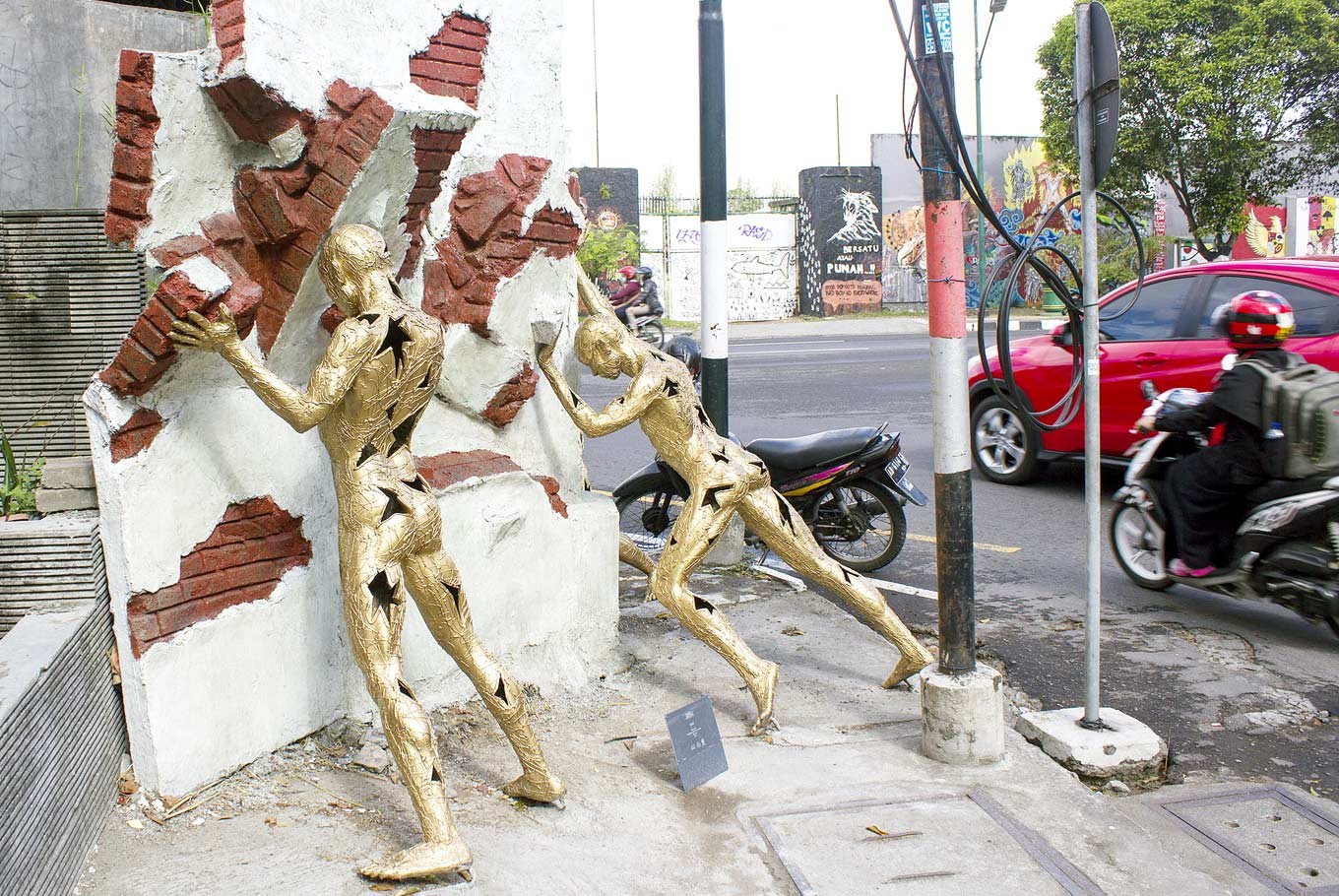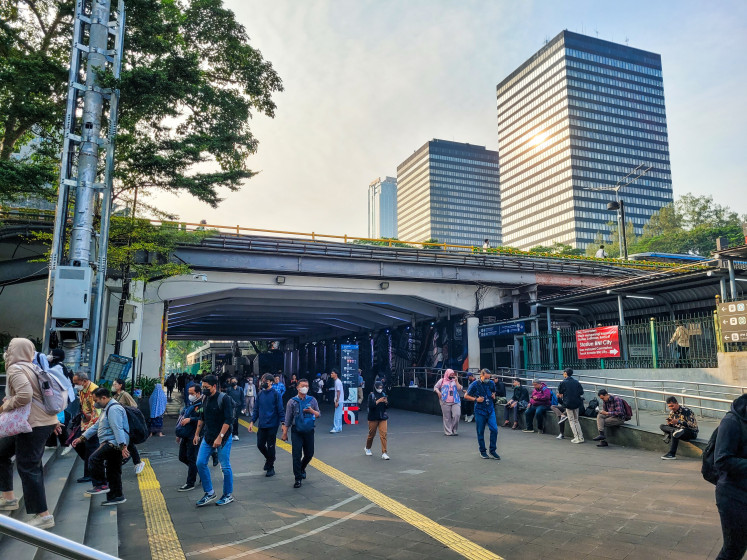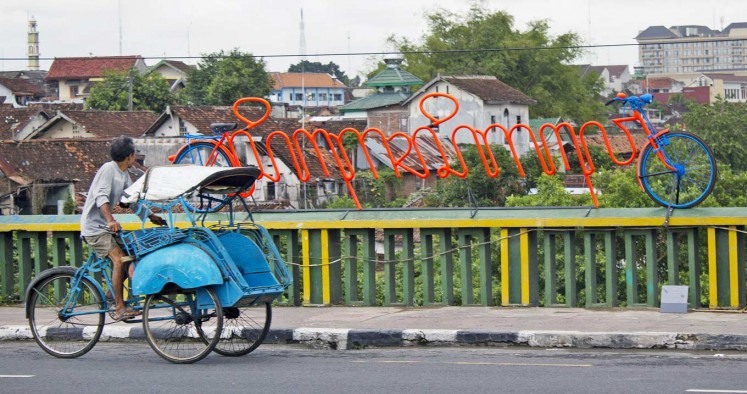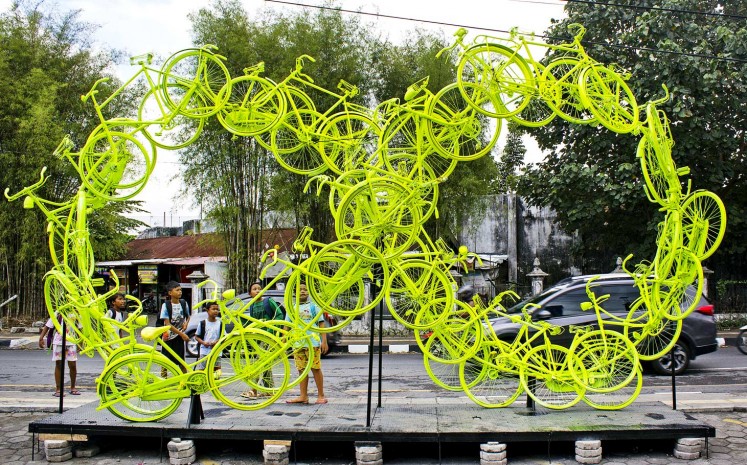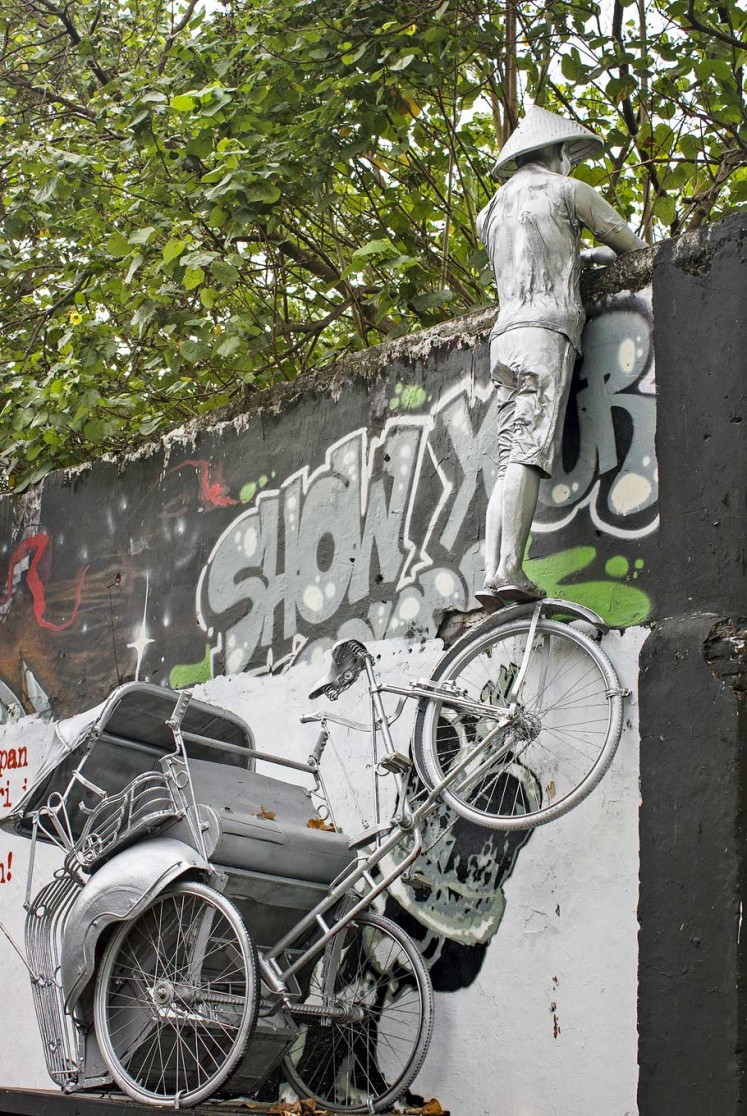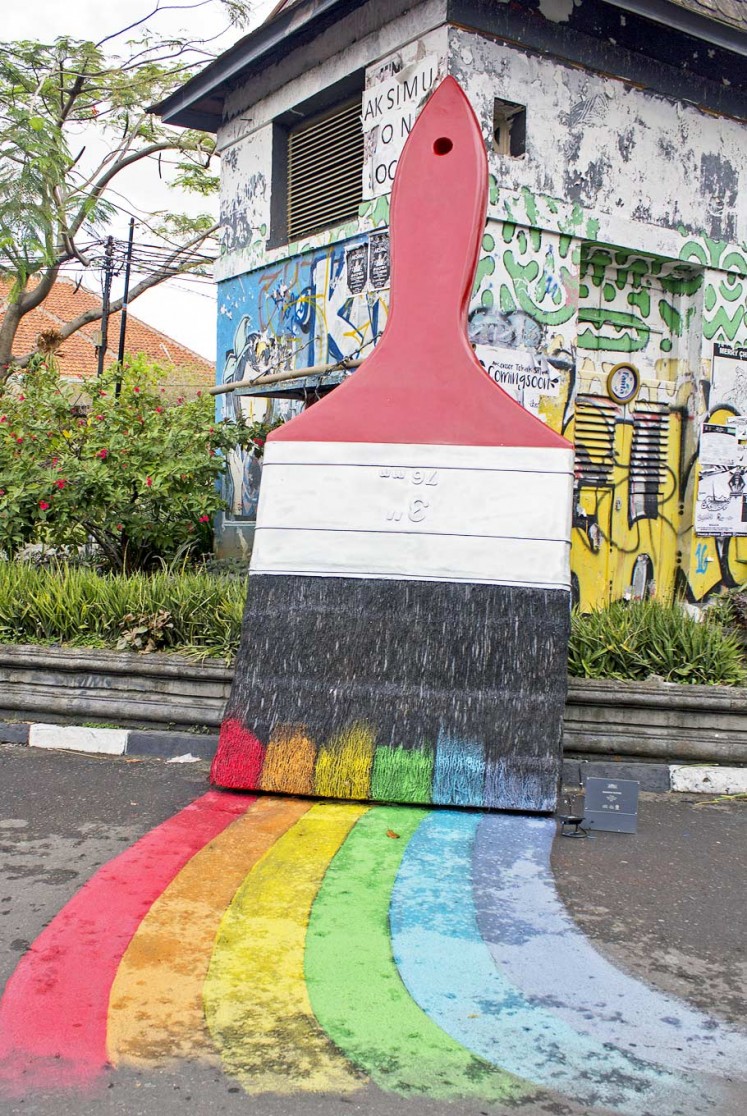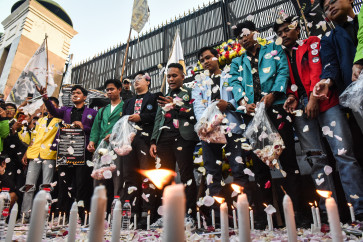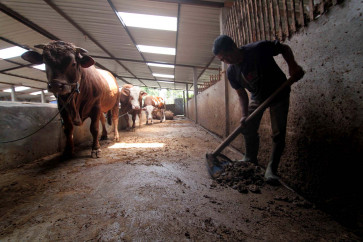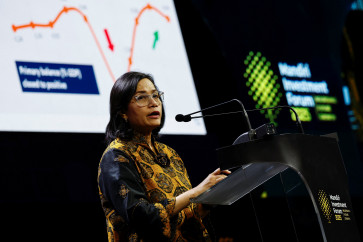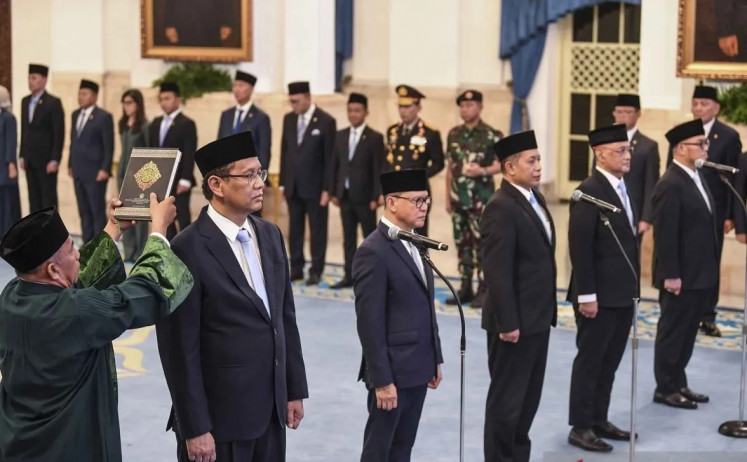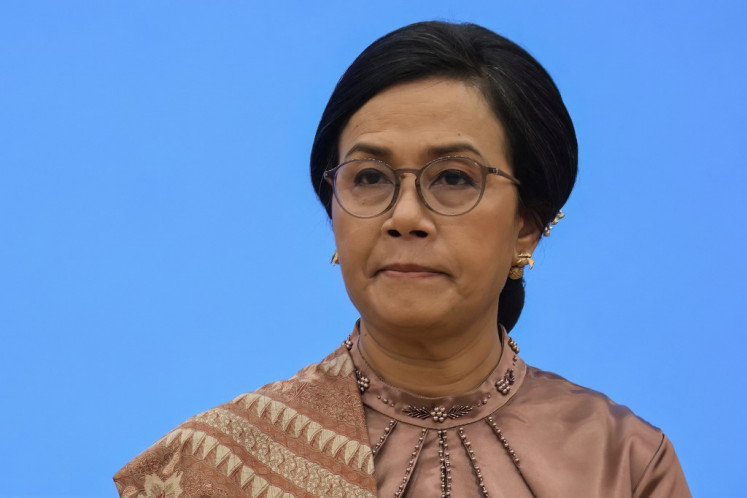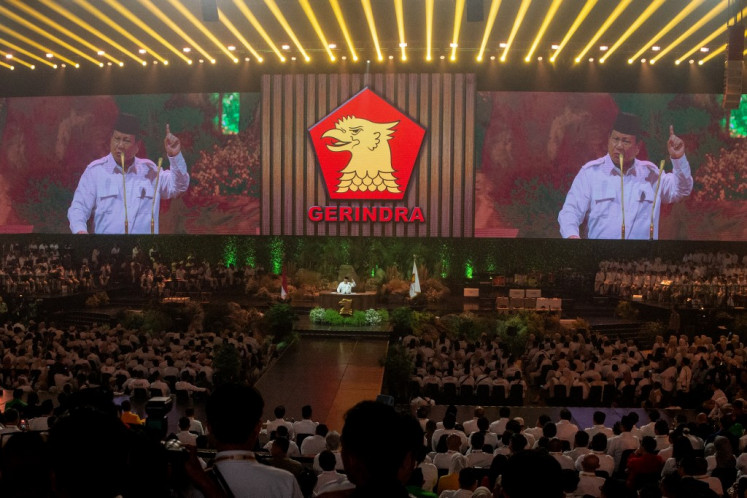Popular Reads
Top Results
Can't find what you're looking for?
View all search resultsPopular Reads
Top Results
Can't find what you're looking for?
View all search resultsStreet sculpture project takes over Yogyakarta's Kotabaru
Kotabaru was chosen as the venue because of the complexities of its landscape, history, and social and economic development.
Change text size
Gift Premium Articles
to Anyone
Those visiting the Kotabaru area in Yogyakarta may notice sculptures of different sizes and designs decorating the heritage area.
The sculptures are a part of a three-month outdoor exhibition called the 2017 Jogja Street Sculpture Project (JSSP). Scheduled to run through Jan. 10, it showcases 54 works of art made by 50 members of the Association of Indonesian Sculptors (API).
“For the JSSP this year, we invited three foreign sculptors to participate; they are from Thailand, Japan and Reunion Island,” said Hedi Hariyanto, chairman of the exhibition’s organizing committee.
The event, which was first held in 2015, adopted the theme “Jogjatopia” this year.
Hedi said Kotabaru was chosen as the venue because of the complexities of its landscape, history, and social and economic development.
“All the works displayed were created to respond to that [complexity],” he said.
He pointed to Angga Deri’s Lakuning Urip (Path of Life) as an example. Placed at the north railing of the Gondolayu Bridge on Jl. Sudirman, it is a response to the Sego Segawe program launched by the Yogyakarta city administration in 2008 to promote the use of bicycles as a mode of transportation.
The sculpture, a mixed media work, takes the form of a vintage bicycle held together with a sign that reads “Sego Segawe.”
The sculptor, Angga, said that the sculpture is a three-dimensional, visual reminder of the cycling program.
“Apart from being a non-polluting and traffic friendly means of transportation, the bicycle is an icon of Yogyakarta city,” Angga explained.
Other sculptures, like Hilman Syafriadi, Dunadi, and Suparman, also responded to this environmental issue.
Hilman’s work, Unity, a circular construction comprising children’s bicycles and iron pipes, was placed in the Angkringan Code culinary area.
Infinity by Dunadi (JP/Tarko Sudiarno)Dunadi’s Infinity is an iron construction comprising small bicycles and aims to evoke memories of the days when bicycles filled the streets of Yogyakarta.
“Today, bicycles are being sidelined [and] superseded by motorcycles,” he said.
Meanwhile, Suparman’s No Tickets depicts a parked bicycle. Both are displayed around Kridosono Sport Hall.
Through their works, the three sculptors express their concerns over the gradual disappearance of bicycles in Yogyakarta — historically known as the city of bicycles — as motorized vehicles multiply at alarming rates.
“Furthermore, I feel that the city has failed to provide the proper facilities for cyclists, such as bicycle parking stands,” Suparman said.
A shift in the people’s lifestyle, in which they have begun to ignore Yogyakarta’s cultural heritage, inspired sculptor Yulhendri to create Kuat. Displayed in front of Angkringan Kobar eatery near the Kridosono Sport Hall, Kuat depicts a group of people struggling to keep a wall from collapsing, representing those who care to preserve cultural values now considered outdated.
“This is a message for the younger generations, [urging them] to preserve historical, cultural and traditional legacies instead of destroying them,” Yulhendri said.
Displayed near a McDonald’s outlet in Kotabaru is a piece by Yani Mariani, one of only two participating female sculptors in the exhibition. Called Maicayang Teges (Give Each Other Meaning), the ovoid-shaped sculpture looks like a piece of fruit that has been sliced into several pieces.
“The separated parts mutually give meaning to one another, [and give] hope for unity or togetherness,” Yani explained.
According to API chairman Anusapati, the annual JSSP is one of the association’s most popular programs and may become a biannual event in the future.
“This year, the exhibit is responding to [Yogyakarta’s] urban heritage. Next time, we will respond to other aspects of the city,” he said, adding that API hoped to invite more international sculptors.
No Many No Live Match by Harry Susantoby younger generations. (JP/Tarko Sudiarno)This year, Akatsuki Harada of Japan presented Return 14, Michael Boyer of Reunion Island presented Chrysalis and Thannathon Suwannonthakul of Thailand presented First Step on the Future.
Kotabaru was developed in the 1800s as a residential complex for Dutch colonial officers working at the sugarcane factory in Madukismo, Bantul regency, said Kotabaru subdistrict head Riyan Wulandari
As such, she said, it was designed to house a range of facilities, including a school, shops, a health clinic, sports center and a military post, with spatial planning and designs that rivaled those of larger cities around the world.
“Hopefully, the JSSP will help promote cultural tourism in Kotabaru,” Riyan said.
Jogjatopia: Enlivens the streets of Yogyakarta
Jogjatopia, an outdoor art exhibit, aims to promote issues such as pluralism, conflict and contestation, commercialism and capitalism, residents’ aspirations and public participation, as well as the social consequences of urban growth.
Among the compelling works displayed at the exhibition is a giant brush leaning against a guardhouse on Jl. Faridan Muridan Noto. Under the brush are colorful stripes, like a rainbow.
Rainbow Culture by Triyono (JP/Tarko Sudiarno)
The artist, Triyono, calls piece Rainbow Culture to represent students from various ethnic and religious backgrounds living together in harmony.
“While studying in Yogyakarta, they interact and are engaged in creative activities together. They have added colors to the city,” Triyono said.
Widayati, a resident, praised the works as unique.
“This exhibition invites us to enjoy artistic creations and reflect on present-day social phenomena,” she said.
Another resident, Maulana, 20, praised the sculptures that had been crafted out of recycled materials, such as food cans and paper.
“The artists have given enough thought to the different aspects of their work, from the materials they use, to the messages they wish to communicate; it’s all very interesting,” Maulana said.
***
Ainur Rohmah also contributed to this story

